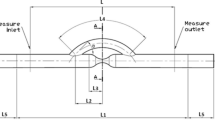Abstract
Flow disturbances in a model of an interposition graft in an arterial segment were measured using an ultrasound Doppler velocimeter. The effect of the degree of compliance mismatch between a stiff ‘graft’ and compliant ‘arterial’ segments was investigated. In steady flow, disturbances were detected when the compliance ratio (stiff to compliant segments) was ≤0·1 and the Reynolds number ≥2200. A recirculation zone just downstream of the distal anastomosis was observed at a Reynolds number ≥2400. Disturbances were also measured under pulsatile flow which consisted of a time-varying component superimposed on a steady flow component. The time-varying flow component was either quasiphysiological or sinusoidal in shape. The Reynolds number was 500 but the frequency parameter varied from 4·2 to 8·5. Significant disturbances were observed for conduits with compliance ratio ≤0·19. The disturbance intensity tended to increase as the compliance ratio decreased and the frequency parameter increased. The magnitude of the disturbance was also greater with the quasiphysiological than the sinusoidal input flow waveform.
Similar content being viewed by others
References
Abbott, W. M., Megerman, J., Hasson, J. E., L'Italien, G. andWarnock, D. F. (1987) Effect of compliance mismatch on vascular graft patency.J. Vasc. Surg.,5, 376–382.
Ahmed, S. A. andGiddens, D. P. (1983) Velocity measurements in steady flow through axisymmetric stenoses at moderate Reynolds numbers.J. Biomech.,16, 505–516.
Ahmed, S. A. andGiddens, D. P. (1984) Pulsatile poststenotic flow studies with laser Doppler anemometry.,17, 695–705.
Annis, D., Bornat, A., Edwards, R. O., Highman, A., Loveday, B. andWilson, J. (1978) An elastomeric vascular prosthesis.Trans. Am. Soc. Artif. Intern. Organs,24, 209–214.
Baird, R. N. andAbbott, W. M. (1976) Pulsatile blood-flow in arterial grafts.Lancet,II, 948–950.
Baker, D. W. andYates, W. G. (1973) Technique for studying the sample volume of ultrasonic Doppler devices.Med. & Biol. Eng.,11, 766–770.
Black, R. A. andHow, T. V. (1989) A pulsed Doppler ultrasound system for the measurement of velocity distributions and flow disturbances in arterial prostheses.J. Biomed. Eng.,11, 35–42.
Callow, A. D. (1982) Current studies of vascular grafts.Surg. Clin. N. America,62, 501–513.
Casty, M. andGiddens, D. P. (1984) 25+1 Channel pulsed ultrasound Doppler velocity meter for quantitative flow measurements and turbulence analysis.Ultrasound in Med. & Biol.,10, 161–172.
De Weese, J. A. (1978) Anastomotic intimal hyperplasia. InVascular grafts.Sawyer, P. N. andKaplitt, M. J. (Eds.), Appleton-Century-Crofts, New York, 147–152.
Fisher, A. C., How, T. V., de Cossart, L. andAnnis, D. (1985) The longer term patency of a compliant small diameter arterial prosthesis: the effects of the withdrawing of aspirin and dipyridamole therapy: the effect of reduced compliance.Trans. Am. Soc. Artif. Intern. Organs,31, 324–328.
Gozna, E. R., Marble, A. E., Shaw, A. andHolland, J. G. (1974) Age relatedchanges in the mechanics of the aorta and pulmonary artery of man.J. Appl. Physiol.,36, 407–411.
Hanel, K. C., McCabe, C., Abbott, W. M., Fallon, J. andMegerman, J. (1982) Current PTFE grafts. A biomechanical scanning electron and light microscope evaluation.Ann. Surg.,195, 456–463.
How, T. V. andAnnis, D. (1987) Viscoelastic behaviour of polyurethane vascular prostheses.J. Biomed. Mat. Res.,21, 1092–1108.
Inokuchi, K., Okadome, K., Ohtsuka, K., Muto, Y., Kuroki, M., Miyazaki, T. andTakahara, H. (1984) A desktop computer to visualize the intraluminal velocity profile and its clinical application.J. Vasc. Surg.,1, 787–794.
Khalifa, A. M. A. andGiddens, D. P. (1981) Characterization and evolution of poststenotic flow disturbances.J. Biomech.,14, 279–296.
Kinley, C. E. andMarble, A. E. (1980) Compliance: a continuing problem with vascular grafts.J. Cardiovas. Surg.,21, 163–170.
Klein, S. R., Goldberg, L., Miranda, R. M., Bosco, P., Nelson, R. J. andWhite, R. A. (1982) Effect of suture technique on arterial anastomotic compliance.Arch. Surg.,117, 45–47.
Liepmann, H. W. (1979) The rise and fall of ideas in turbulence.Am. Sci.,67, 221–228.
LoGerfo, F. W., Soncrant, T., Teel, T. andDewey, C. F. (1979) Boundary layer separation in models of side-to-end arterial anastomoses.Arch. Surg.,114, 1369–1373.
Mozersky, D. J., Sumner, D. S., Hokanson, D. E. andStrandness, D. E. (1972) Transcutaneous measurement of the elastic properties of the human femoral artery.Circ.,46, 948–955.
Nahon, D., Lee, J. M. andWilson, G. J. (1986) A two-dimensional incremental study of the static mechanical properties of vascular grafts.Clin. Materials,1, 177–197.
Rittgers, S. E., Karayannacos, P. E., Guy, J. F., Nerem, R. M., Shaw, G. M., Hostetler, J. R. andVasko, J. S. (1978) Velocity distribution and intimal proliferation in autologous vein grafts in dogs.Circ. Res.,42, 792–801.
Roshko, A. (1976) Structure of turbulent shear flow: a new look.AIAA J.,14, 1349–1357.
Schmid-Schonbein, H., Born, G. V. R., Richardson, P. D., Cusack, N., Rieger, H., Forst, R., Rohling-Winkel, I., Blasberg, P. andWehmeyer, A. (1981) Rheology of thrombotic process in flow: the interaction of erythrocytes and thrombocytes subjected to high flow forces.Biorheology,18, 415–444.
Sottiurai, V. S., Yao, J. S. T., Flinn, W. R. andBatson, R. C. (1983) Intimal hyperplasia and neointima: an ultrastructural analysis of thrombosed grafts in humans.Surg.,93, 809–817.
Talukder, N., Fulenwider, J. T., Mabon, R. F. andGiddens, D. P. (1986) Poststenotic flow disturbance in the dog aorta as measured with pulsed Doppler ultrasound.J. Biomech. Eng.,108, 259–265.
Walden, R., L'Italien, G. J., Megerman, J. andAbbott, W. M. (1980) Matched elastic properties and successful arterial grafting,Arch. Surg.,115, 1166–1169.
Yamaguchi, T., Kikkawa, S., Yoshikawa, T., Tanishita, K. andSugawara, M. (1983) Measurement of turbulence intensity in the center of the canine ascending aorta with a hot-film anemometer.J. Biomed. Eng.,105, 177–187.
Yongchareon, W. andYoung, D. F. (1979) Initiation of turbulence in models of arterial stenoses.J. Biomech.,12, 185–196.
Young, D. F. (1979) Fluid mechanics of arterial stenoses.J. Biomech. Eng.,101, 157–174.
Author information
Authors and Affiliations
Rights and permissions
About this article
Cite this article
Miyawaki, F., How, T.V. & Annis, D. Effect of compliance mismatch on flow disturbances in a model of an arterial graft replacement. Med. Biol. Eng. Comput. 28, 457–464 (1990). https://doi.org/10.1007/BF02441969
Received:
Accepted:
Issue Date:
DOI: https://doi.org/10.1007/BF02441969




